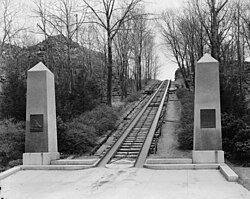This article includes a list of general references, but it lacks sufficient corresponding inline citations. (October 2012) |
| Quincy Granite Railway | |
|---|---|
 | |
| Commercial operations | |
| Original gauge | 5 ft (1,524 mm) |
| Preserved operations | |
| Preserved gauge | 5 ft (1,524 mm) |
Quincy Granite Railway Incline | |
 The Incline section of the Granite Railway Quincy (1934 photo) | |
| Location | Mullin Ave., Quincy, Massachusetts |
|---|---|
| Coordinates | 42°14′43″N 71°2′14″W / 42.24528°N 71.03722°W |
| Area | 0.2 acres (0.08 ha) |
| Built | 1826 |
| NRHP reference No. | 73000310[1] |
Quincy Granite Railway | |
| Location | Bunker Hill Lane, Quincy, Massachusetts |
| Coordinates | 42°14′23″N 71°1′57″W / 42.23972°N 71.03250°W |
| Area | 0.7 acres (0.3 ha) |
| Built | 1826 |
| NRHP reference No. | 73000309[1] |
| Added to NRHP | October 15, 1973 |
| Added to NRHP | June 19, 1973 |
The Granite Railway was one of the first railroads in the United States, built to carry granite from Quincy, Massachusetts, to a dock on the Neponset River in Milton. From there boats carried the heavy stone to Charlestown for construction of the Bunker Hill Monument. The Granite Railway is popularly termed the first commercial railroad in the United States, as it was the first chartered railway to evolve into a common carrier without an intervening closure. The last active quarry closed in 1963; in 1985, the Metropolitan District Commission purchased 22 acres (8.9 ha), including Granite Railway Quarry, as the Quincy Quarries Reservation.
- ^ a b "National Register Information System". National Register of Historic Places. National Park Service. March 13, 2009.

